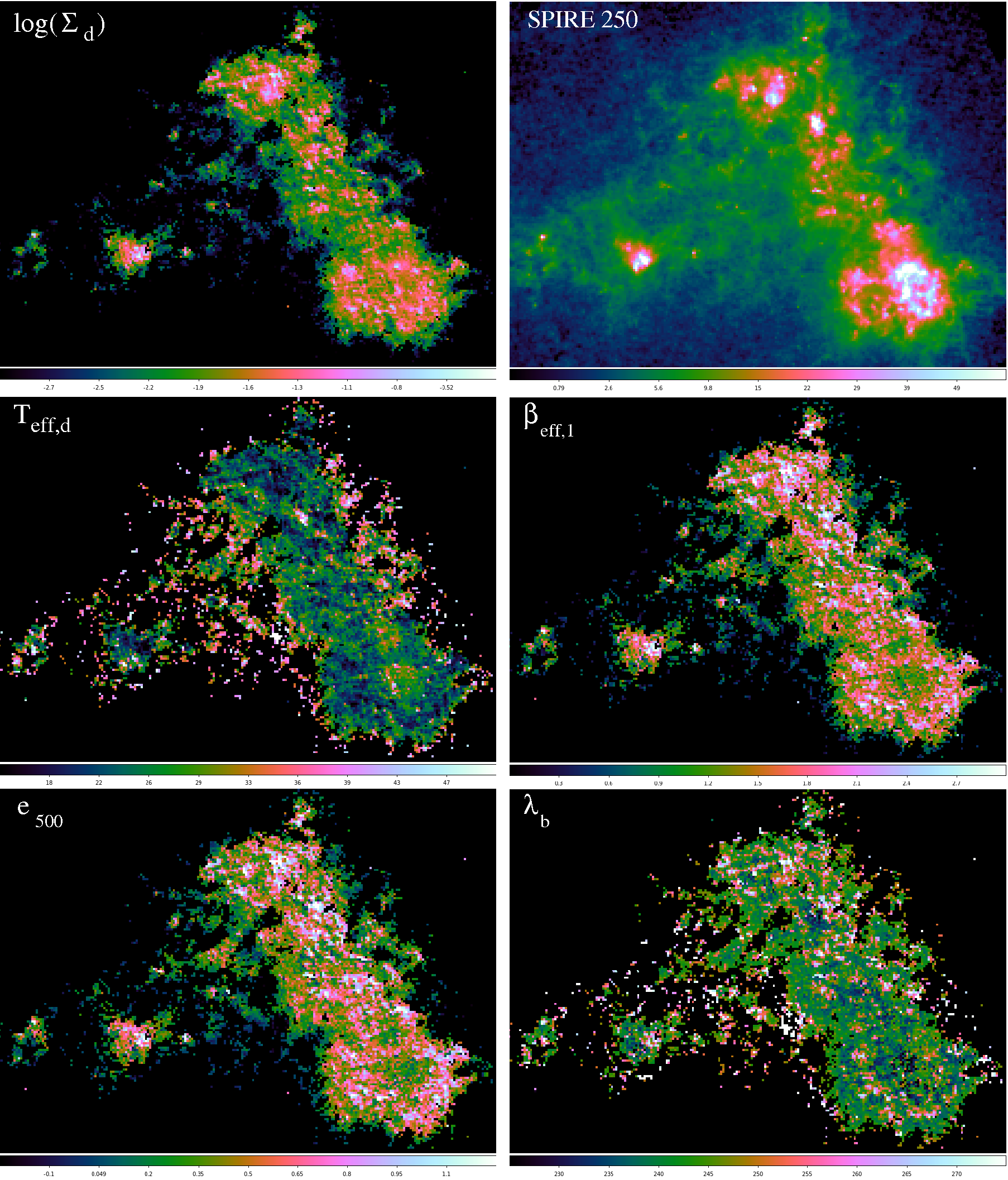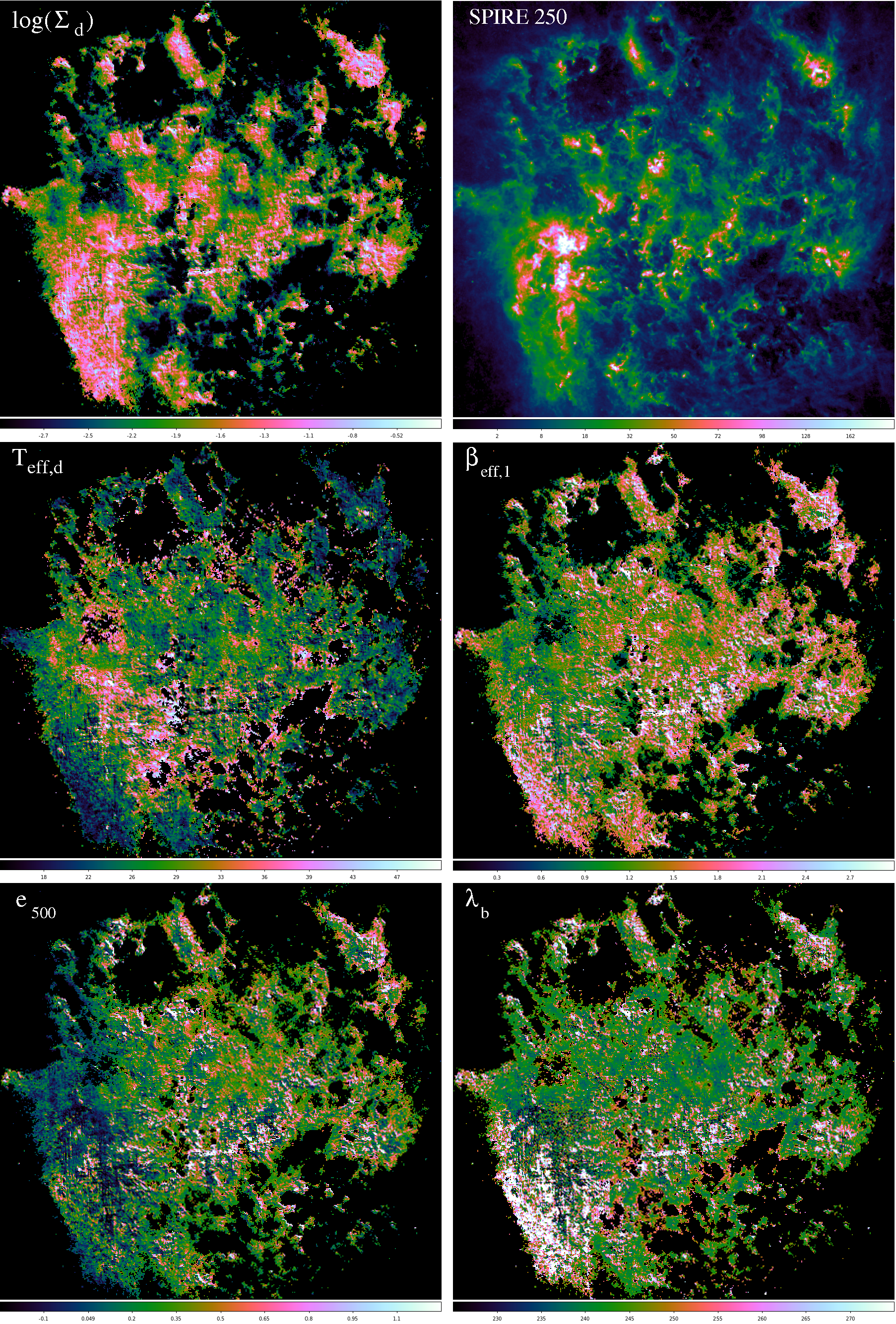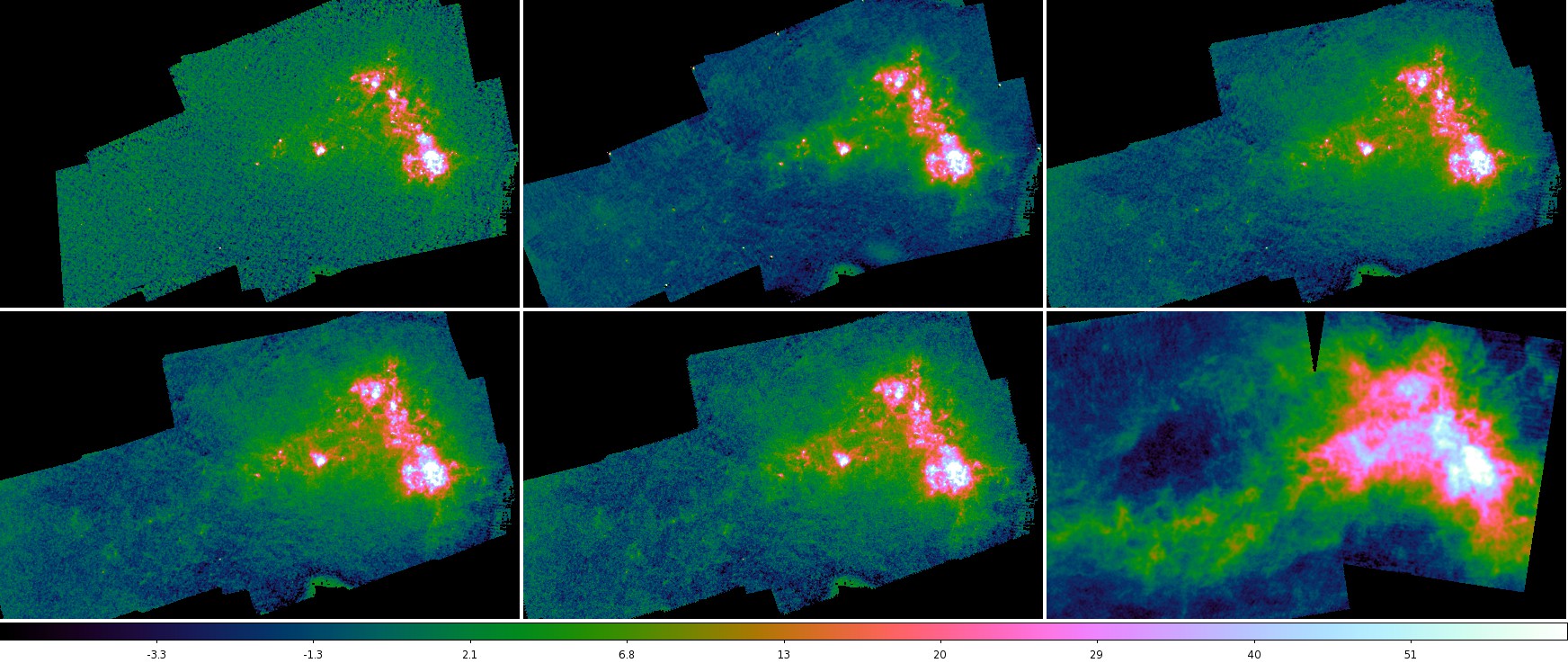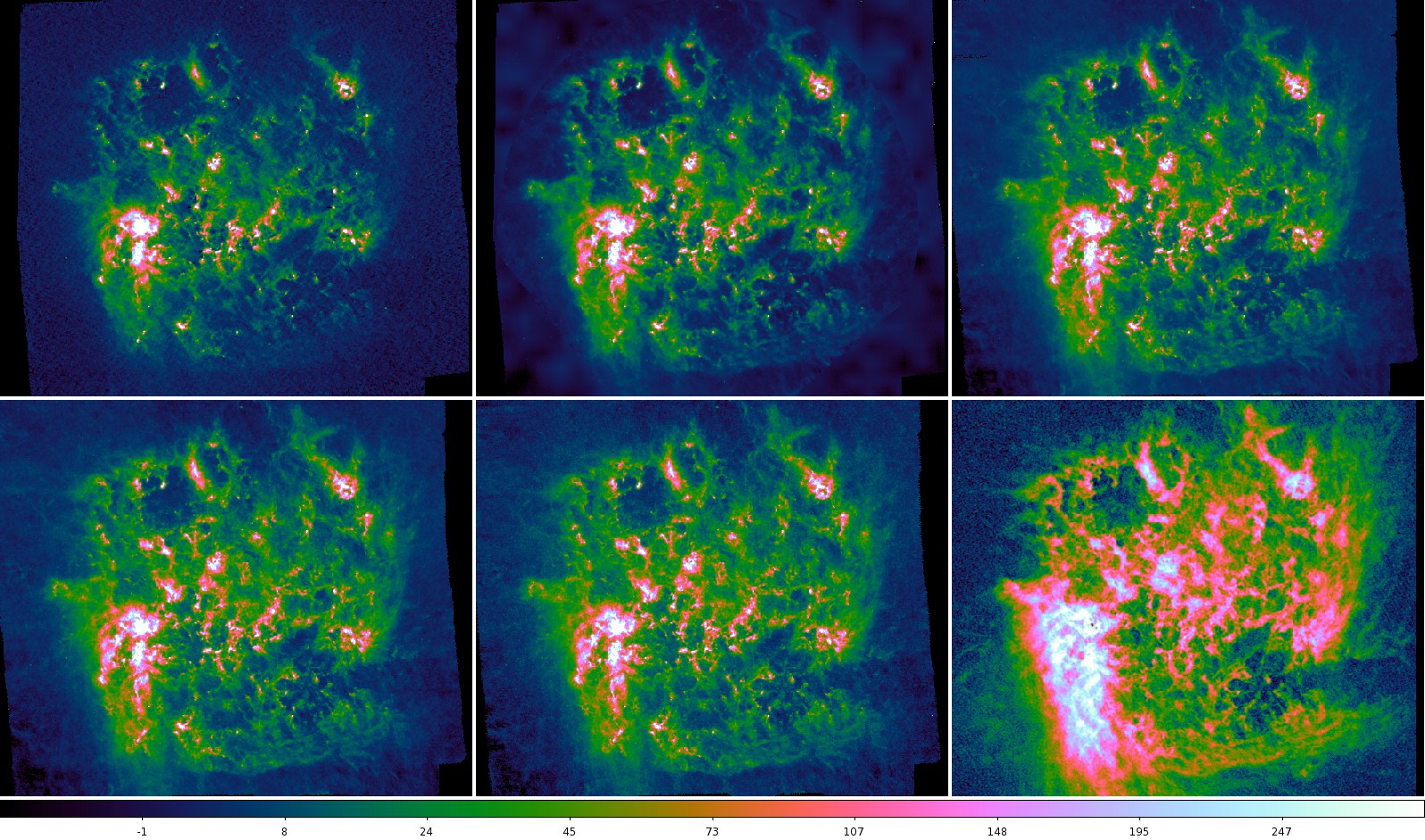Dust and Gas in the Magellanic Clouds from the HERITAGE Herschel Key Project. I. Dust Properties and Insights into the Origin of the Submm Excess Emission
Karl D. Gordon, Julia Roman-Duval, Caroline Bot, Margaret Meixner, et. al. 2014, ApJ, 797, 85
The dust properties in the Large and Small Magellanic clouds (LMC/SMC) are studied using the HERITAGE Herschel Key Project photometric data in five bands from 100 to 500 µm. Three simple models of dust emission were fit to the observations: a single temperature blackbody modified by a power-law emissivity (SMBB), a single temperature blackbody modified by a broken power-law emissivity (BEMBB), and two blackbodies with different temperatures, both modified by the same power-law emissivity (TTMBB). Using these models, we investigate the origin of the submillimeter excess, defined as the submillimeter emission above that expected from SMBB models fit to observations >200 µm. We find that the BEMBB model produces the lowest fit residuals with pixel-averaged 500 µm submillimeter excesses of 27% and 43% for the LMC and SMC, respectively. Adopting gas masses from previous works, the gas-to-dust ratios calculated from our fitting results show that the TTMBB fits require significantly more dust than are available even if all the metals present in the interstellar medium (ISM) were condensed into dust. This indicates that the submillimeter excess is more likely to be due to emissivity variations than a second population of colder dust. We derive integrated dust masses of (7.3 ± 1.7) × 105 and (8.3 ± 2.1) × 104 M☉ for the LMC and SMC, respectively. We find significant correlations between the submillimeter excess and other dust properties; further work is needed to determine the relative contributions of fitting noise and ISM physics to the correlations.
The full paper is available at ADS in multiple formats. Please see this paper for all the details on how the data and results below were obtained.
Please reference Gordon et. al. 2014, ApJ, 797, 85 if you use these results in a paper, talk, poster, etc. Thanks.
Dust Parameter Maps
Spatially resolved fits were done using three different dust emission models. The 1st is a single temperature modified by a power law emissivity law (SMBB). The 2nd is the broken emissivity model with dust grains with a single temperature and a broken emissivity law (BEMBB). The 3rd is the two temperature model with 2 dust grains with different temperatures and a single unbroken emissivity law (TTMBB). Each dust emission model provides results in two flavors, depending on the prior/assumption on range of beta values allowed. The set of results are then priors are:
- SMBB, beta unconstrained (formally -1 to 4)
- SMBB, beta constrained to be between (0.8, 2.5) based on laboratory measurements on amorphous carbonaceous and silicate grains.
- BEMBB, beta1 unconstrained (formally -1 to 4)
- BEMBB, beta1 constrained to be between (0.8, 2.5) based on laboratory measurements on amorphous carbonaceous and silicate grains.
- TTMBB, beta unconstrained (formally -1 to 4)
- TTMBB, beta constrained to be between (0.8, 2.5) based on laboratory measurements on amorphous carbonaceous and silicate grains.
The "best fit" parameters are presented in 3 flavors.
- 'max' method: the classical best fit where the fit parameters are given by the model the best fits the data
- 'exp' method: the expectation value of the full likelihood function for each parameter (includes the non-symmetries in the likelihood functions)
- 'realize' method: a single realization of the likelihood function for each pixel (best for analyses looking at the ensemble behavior of the pixels)
only 1 'realization' provided, more are available upon request (the number of pixels in each galaxy is such that the ensemble behavior does not change much between realizations)
The files are FITS files with extensions. Each extension has a different fit parameter and is identified by the 'extname' keyword in the extension header. The links are to .tar.gz files containing the spearate files.
BEMBB Model Fits: Recommended Model (based on fit residuals and gas-to-dust ratios - see paper)
- SMC (s500, 56" pixels, beta1 unconstrained)
- SMC (s500, 56" pixels, 0.8 < beta1 < 2.5)
- LMC (s500, 56" pixels, beta1 unconstrained)
- LMC (s500, 56" pixels, 0.8 < beta1 < 2.5)


SMBB Model Fits (19apr14): Has the largest fitting residuals of all 3 models
(provide for completeness)
- SMC (s500, 56" pixels, beta unconstrained)
- SMC (s500, 56" pixels, 0.8 < beta < 2.5)
- LMC (s500, 56" pixels, beta unconstrained)
- LMC (s500, 56" pixels, 0.8 < beta < 2.5)
TTMBB Model Fits (19apr14): Gives significantly lower gas-to-dust ratio than is reasonable (or even possible for the LMC)
(provided for completeness)
- SMC (s500, 56" pixels, beta unconstrained)
- SMC (s500, 56" pixels, 0.8 < beta < 2.5)
- LMC (s500, 56" pixels, beta unconstrained)
- LMC (s500, 56" pixels, 0.8 < beta < 2.5)
Herschel Data Used
These images are convolved to the SPIRE 500 micron resolution (using the Aniano et. al. 2011 kernels, MW foreground subtracted using a scaled version of the MW foreground HI map, and background subtracted (using a 2D polynomical surface to regions outside the galaxy). Note I've also include the HI data with the same background subtraction for consistency. The data come in two forms, "native SPIRE 500" and rebinned to 56" pixels to provide pixels that are nominally independent.
The links are to .tar.gz files containing the spearate files.
- SMC (s500, 14" pixels) bkgsub: SMC PACS/SPIRE convolved to SPIRE 500 res, MW cirrus subtracted, bkg subtracted
- SMC (s500, 56" pixels) bkgsub: SMC PACS/SPIRE convolved to SPIRE 500 res, MW cirrus subtracted, bkg subtracted, rebined to nominally independent 56" pixels
- LMC (s500, 14" pixels) bkgsub: LMC PACS/SPIRE convolved to SPIRE 500 res, MW cirrus subtracted, bkg subtracted
- LMC (s500, 56" pixels) bkgsub: LMC PACS/SPIRE convolved to SPIRE 500 res, MW cirrus subtracted, bkg subtracted, rebined to nominally independent 56" pixels
The images shown below are ordered:
PACS 100 micron, PACS 160 micron, SPIRE 250 micron
SPIRE 350 micron, SPIRE 500 micron, HI 21 cm



